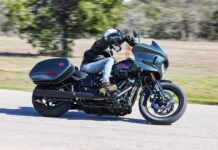
Diego Cardenas rode his LiveWire border-to-border, making Harley-Davidson history for his 50th birthday
Words by Joy Burgess
Photos courtesy of Diego Cardenas and Harley-Davidson
“I just wanted to do something different, and different became extraordinary,” said Diego Cardenas – a technologist by trade – the first time we talked. And in that moment I knew there was a story here that needed to be told. After all, far too many people in life settle for the ordinary instead of chasing the extraordinary, especially since Covid-19 has left so many with their lives on pause.
When the pandemic ruined Cardenas’ plans to travel to Spain for his 50th birthday, he didn’t let it wreck his celebration. Instead, he chose to do something mind-blowing to celebrate his half century on earth: riding the Harley-Davidson LiveWire from the U.S./Mexican border to the U.S./Canadian border via the West Coast Green Highway (WCGH), a network of DC fast-charging stations for electric vehicles located every 25-50 miles along Interstate 5 and additional major roads through California, Oregon and Washington.
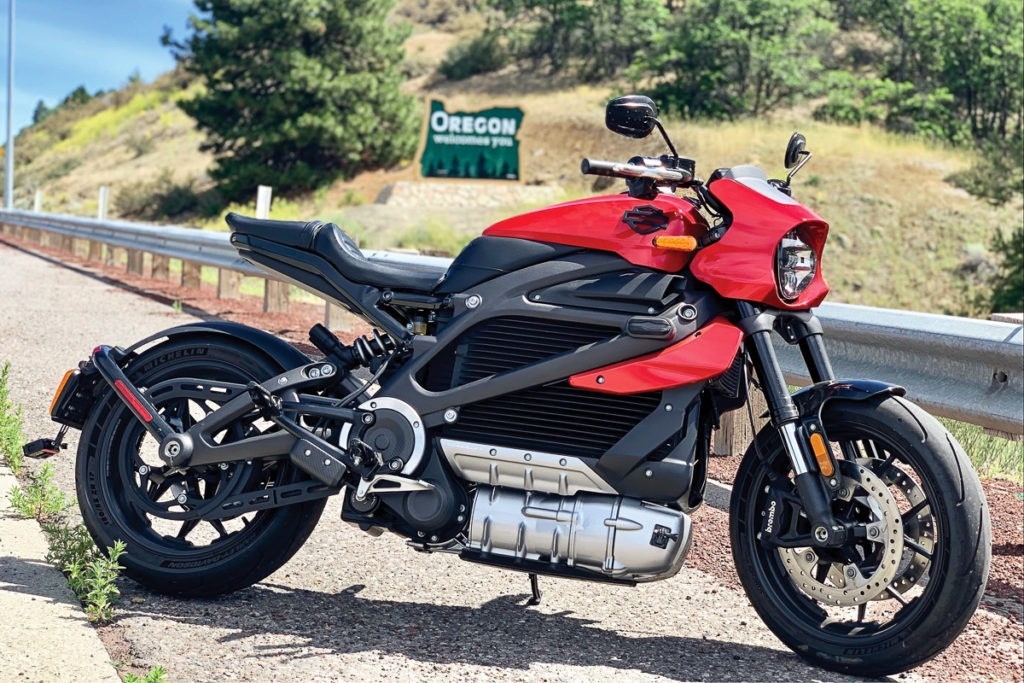
Cardenas rode over 1,400 miles aboard the electric-powered LiveWire, and learned to squeeze every bit of juice from its battery. He also dealt with a lost key fob (a bigger deal than you might imagine), and rode through “crazy-ass” thunderstorms to complete his birthday trek. “I wasn’t out to prove I was the fastest or quickest,” he said. “I was out to prove that electric technology is reliable, and to be an inspiration for others to try riding e-motorcycles like the LiveWire.”
But long before Cardenas did his LiveWire journey, he fell in love with motorcycles, the Harley-Davidson motor company, the V-Rod and, eventually, the LiveWire.

Falling in Love with the Motor Company
Born in Colombia, Cardenas didn’t come to the U.S. until he was nine years old. While motorcycling is mostly an entertainment sport in the U.S. (and an expensive one), motorcycles in Colombia were used as everyday transportation, and more accessible. “Cars were more of a luxury in Columbia back in the ‘80s,” Cardenas said, “and my first bikes were 125cc bikes like Hondas and Suzukis.”
While he started riding young, it wasn’t until coming to the States that he began seeing some bigger bikes, V-twins by Yamaha, Honda, Indian, and of course, Harley-Davidson, too. It wasn’t long until the bar and shield grabbed him and ignited a love affair that’s lasted for years.
“My first Harley was a ’95 black Sportster,” he said. “I loved that bike, and that’s when I fell in love with the brand, the lifestyle and the prestige. But I needed a bit more. My wife likes to say that every few years I have a middle-age crisis, and I buy a new one. I’ve had seven or eight bikes in my lifetime, and the last three have been Harleys.”
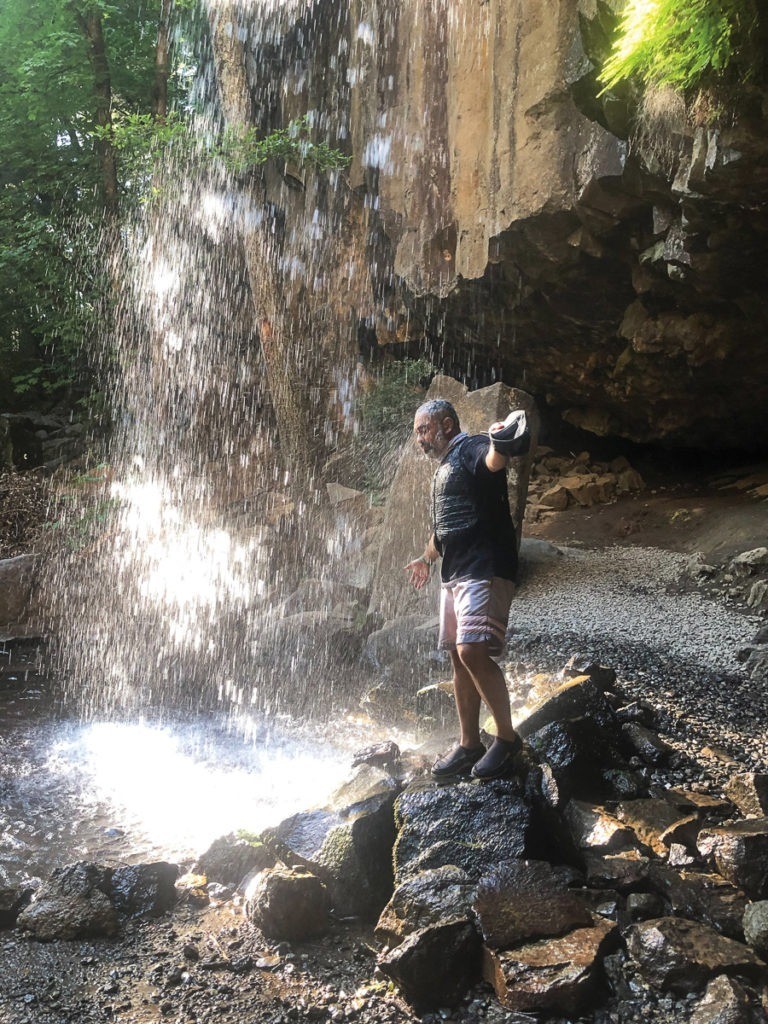
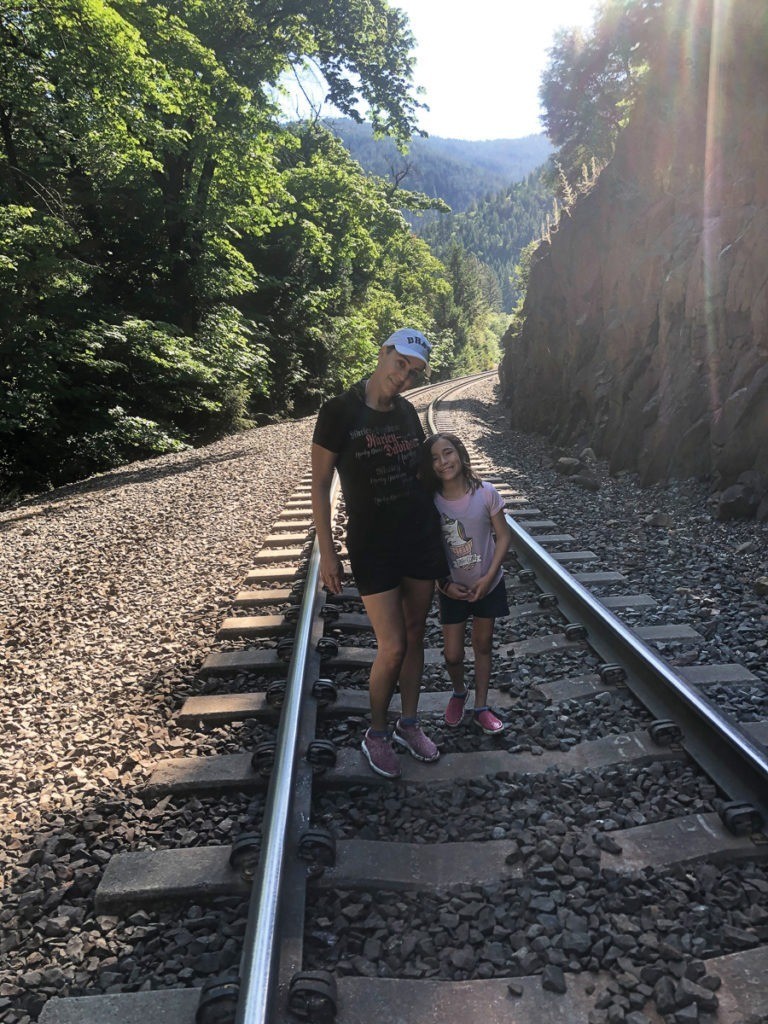
“I was looking for something new,” Cardenas continued, “and at the time the American chopper scene was all the rage. But I got sidetracked when I saw the making of the V-Rod on the Discovery Channel. It had everything I wanted…prestige, performance, cruisability, and all in one bike. There weren’t a lot of them around, so I bought an original, ‘02 silver V-rod – the silver bullet – from out of state, and since then it’s been a love affair. I’ve been running that thing for about 18 years.”
LiveWire… Take My Money!
But new Harleys can be an addiction, and Cardenas once again started looking for something new. “I started looking at new motorcycles,” he mentioned, “and almost bought an FXDR, but I just didn’t feel it. You know, it has to come from within. So when Harley announced the 2019 LiveWire, and I saw it being tested and heard the marketing spiel, I was thinking, ‘take my money!’ I’m already an electric guy. I drive a Tesla. But I like performance, too. I was never sold on the Zero. I tested it, but it never sold me; the switch didn’t flip.”
“In June of 2019,” he went on, “I’d heard they were having a big LiveWire event in Huntington Beach and I wanted to try the bike. I pulled up on my V-rod and the guy running the roadshow was a V-rod guy, too. Well, V-rod guys are brothers, so I told him I was all hot and bothered by the LiveWire and wanted as much time on the bike as possible. I took off for two hours! I knew where the chargers were (because I drive a Tesla), so I charged up and kept going. That sealed the deal.”

He might have been ready to let Milwaukee take his money, but actually getting a LiveWire wasn’t so easy. Some dealers had them, but they were for demo use. Finally, he found one at Laidlaws Harley-Davidson in Baldwin Park, California, and bought it as soon as it was assembled. “There are pictures of me hugging that thing,” he says with a laugh.
So… How did the guy who fell in love with the performance of the V-Rod end up choosing a LiveWire? “I’m a brand guy, and I really like this new technology and where it came from,” he says. “The specs are insane! Yes, the V-Rod and LiveWire are two totally different beasts. The V-Rod is a straight-line machine, not a great handler, and it generates what I call ‘controlled chaos.’ The LiveWire is really powerful, too, but it does it differently, since the Revelation motor makes max torque immediately. It’s got unreal handling capabilities, too. I call the LiveWire ‘computer-controlled chaos!’”

Cardenas isn’t the only one drawn to the LiveWire. “A few months ago,” he mentioned, “We got together some of the top e-bikes in San Francisco. We had the LiveWire, the Lightning Strike, a bunch of Zeros and Energicas. We lined them up, and everyone gravitated to the LiveWire. I attribute that to the H-D brand. Harley has heart. When you sit on a Harley-Davidson, it feels like 117 years of craftsmanship, just brought forward to today’s technology.”
“I’m a brain cancer survivor, I’m a firm believer that the day that God wants you, he’ll take you. You kind of have to have that attitude out there. That being said… go ahead and get that bike. You don’t want to be that guy in bed at 95 years of age with regrets.”
Yes, there are plenty of haters for the LiveWire, and Thunder Press got hate mail galore when our cover story hit the shops back in August of 2019. Editor Boehm called it “seriously sporty, shockingly fast and whisper-quiet,” and while people who actually ride the bike are blown away, the haters remain. So be it.
A Mind-Blowing 50th Birthday Celebration
Cardenas had already been enjoying his LiveWire for months when his 50th birthday rolled around. “I was turning 50 on June 30th,” he said, “and since my ancestors were from Spain, originally I was going to go there and take my daughters with me for my birthday. But with Covid-19, that plan flew out the window. And of course, we couldn’t throw a party because we’d get busted by the cops in California. I’m celebrating 50, so I’m on borrowed time [laughs], and I wanted to do something my kids and grandkids would find memorable.”
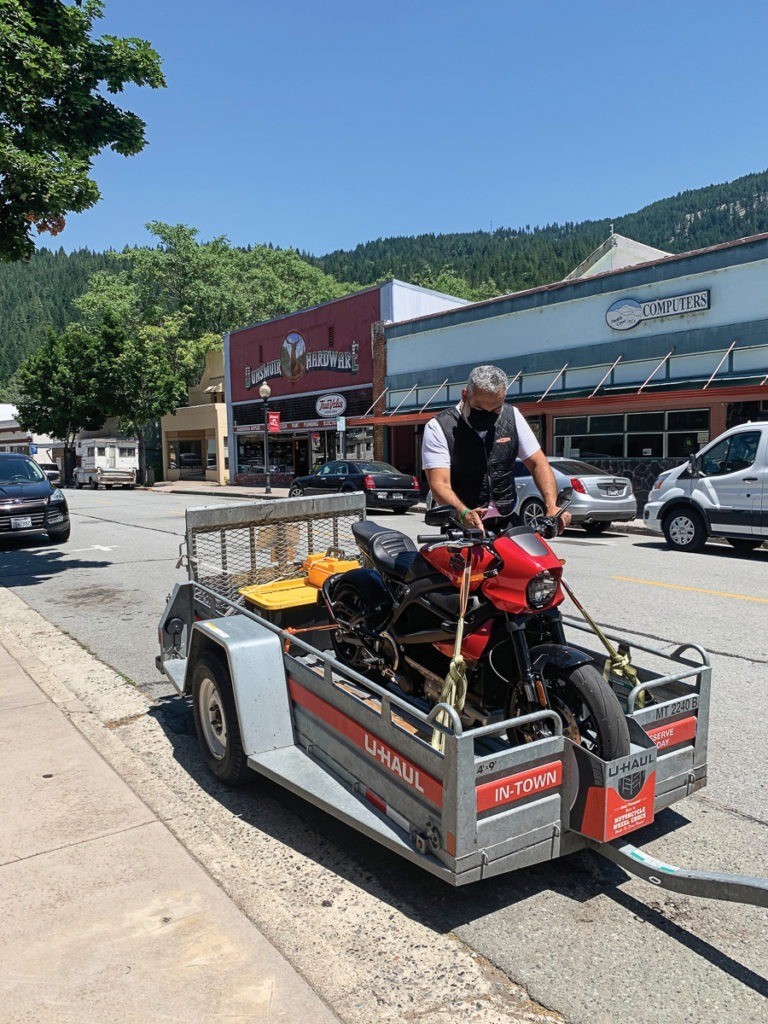
On a trip from San Francisco to LA, Cardenas saw the sign for the West Coast Green Highway – a network of charging stations that take you up the coast – while at a charging stop. It was enough to plant a seed, and he started planning.
“I started thinking, did a little map, and did some routing. Then I told my wife one day, ‘I want to go to Canada on my electric bike for my birthday.’ She’s a road trip girl, too, and she said ‘yeah!’ So I planned to put her in the chase vehicle with my younger daughter.”
While Cardenas planned to head up the West Coast Green Highway for easy access to charging stations, he knew he’d have to plan for problems, so he brainstormed on how he’d handle being left without a charge. “In Colombia, when you run out of gas you just grab onto a bus,” he laughed, “but Harley-Davidson said that towing the LiveWire wasn’t a good idea, and it made the top guys nervous.”
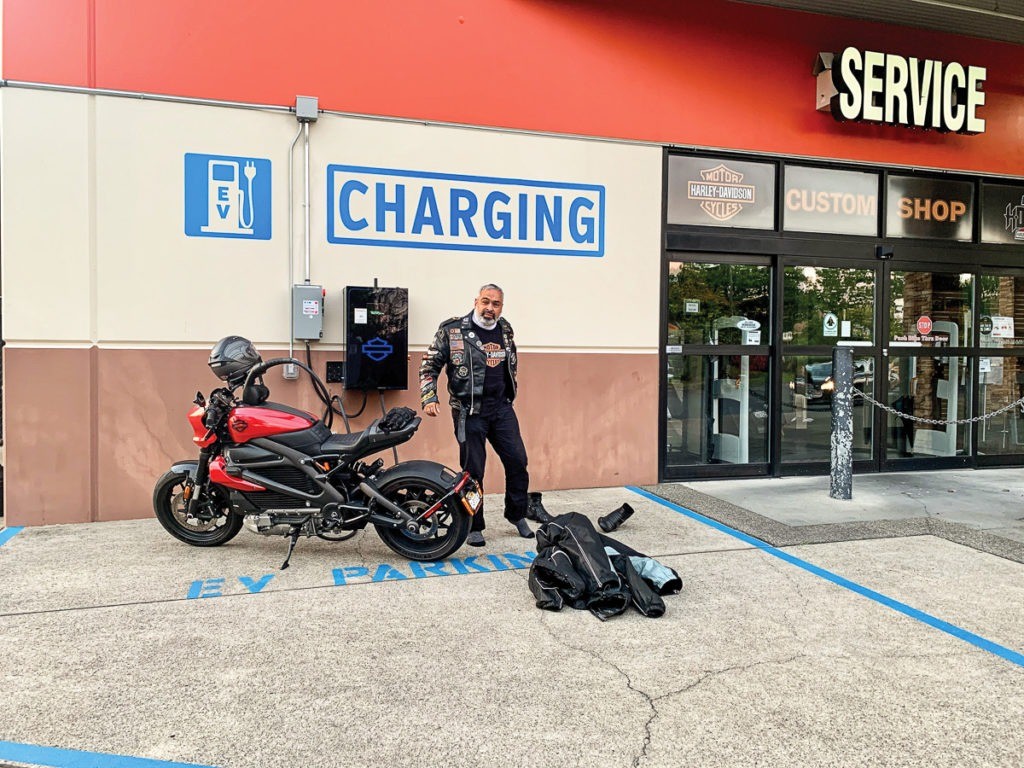
Towing was out, so he rented a trailer in case it was needed (it would be). “I planned out my route, started out and hit every station along the WCGH,” he said. “Theoretically, the bike has a limit of 146 miles on the street and 90-100 miles on the highway depending on how you ride. To be safe, I usually plan for my bike to do about 80 miles. I used PlugShare to calculate my route, and some stops were at 80 miles while others were at 75, but I hit every charging station within 7-10 miles of range. I stuck with mostly Electrify America stations because they have multiple chargers. At non-Electrify America stations, there’s often only one charger, and if it doesn’t work, you’re screwed.”
Along with Electrify America stations, Charge Point stations were his second choice, with EV-GO stations his third. “I kept my speed at about 65 mph to maximize my range,” he said. “I started learning to change my riding mode on the bike to maintain that 65 mph with the least amount of energy. When going downhill I’d put it in Eco mode where it helped me charge up more. I tried to squeeze a bit more power out of it, and I never had a problem running out of juice…the only problem I had was losing the key fob [laughs]!”
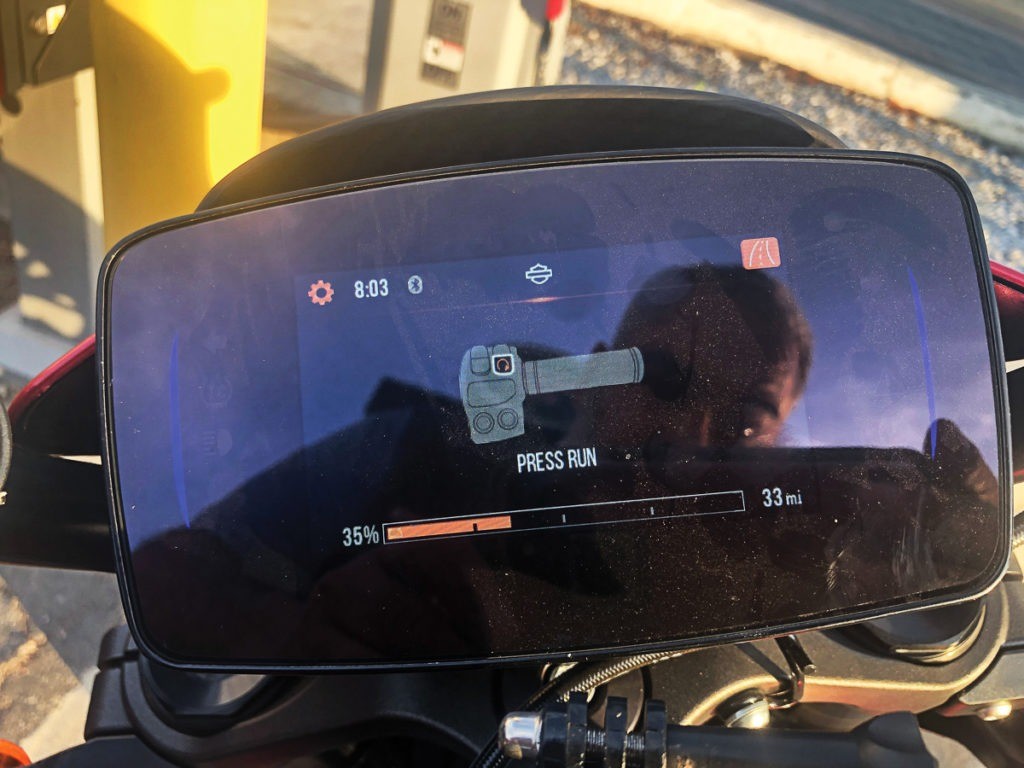
A couple days into the journey, traveling through the desert, the bike started getting hot. “I was freaking out about the bike temperature,” Cardenas said. “I’d just finished charging it, I’m in the desert and it’s about 105 degrees, and I always keep my eye on the temperature of the battery. It hit 117 degrees, so I called H-D tech support – I have them on speed dial.”
Despite the worry, tech support said if the bike wasn’t showing any errors he shouldn’t worry about it. And in the end, it wasn’t the bike that went down because of the heat – it was his wife. “We hit the next charging station and suddenly I heard a boom. My wife passed out. I poured water on her, cooled her off in the car. She hadn’t hydrated and had heat stroke. I asked if she was okay to continue, but after hydrating and cooling off, she said she was okay to go.”

But things got worse. “At the next charging station I plugged in the bike and 45 minutes later I went to turn it on and it wouldn’t start. I‘d lost the key fob. So I tried to pin start the bike, even calling my daughter back in California to check the pin on the paperwork. Still wouldn’t start. Called Laidlaws H-D for the pin; still didn’t work. Called tech services (again) and got a new key fob mailed to me at a lodge at Shasta Mountain. We hauled the bike on the trailer to the lodge, and it was great vacationing. It’s the best nature in the world there with beautiful cascades and waterfalls.”
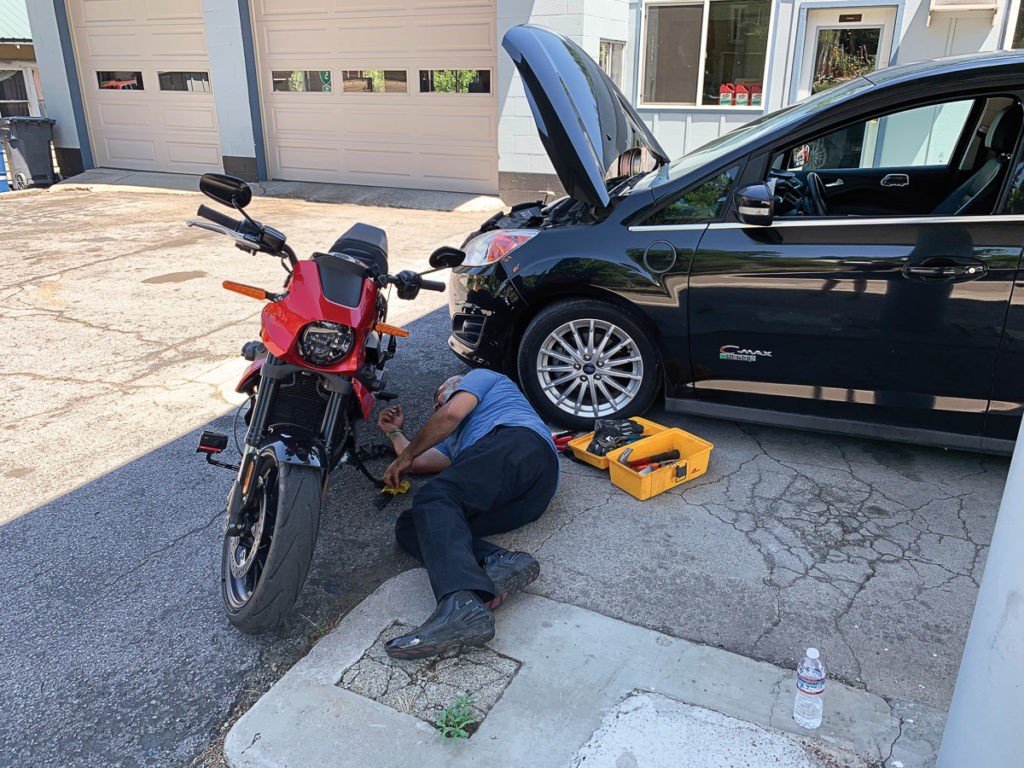
The fob showed up the next day but it still didn’t work,” he remembers, “and this is where the network of H-D dealerships is worth the $30K you pay for the bike. Took the bike to the Redding H-D dealer on the trailer and with the help of tech support we found out that the key fobs didn’t get remarried to the bike the last time it was serviced at Laidlaws H-D, and the pin code didn’t work because it had been written down wrong – it was off by two numbers. They had to reprogram the bike. But hey, it’s not a road trip without some problems, right? [laughs]”
He also dealt with a “nasty-ass thunderstorm” in Washington, and remember, the LiveWire doesn’t have a big fairing on it to offer protection from the elements. “In the beginning,” Cardenas said, “you’re excited about the trip. But after about the fourth day of 10-plus hours a day, your legs start cramping, your butt starts hurting. The bike isn’t a touring bike, but I’m a V-rod rider, so I’m used to that.”
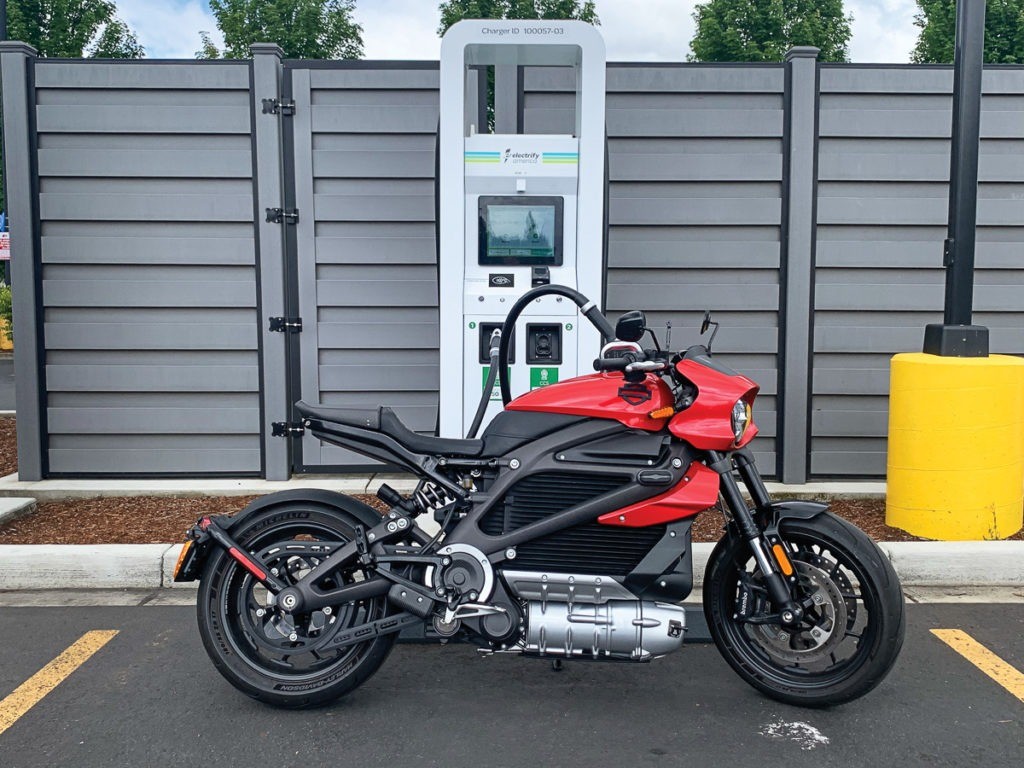
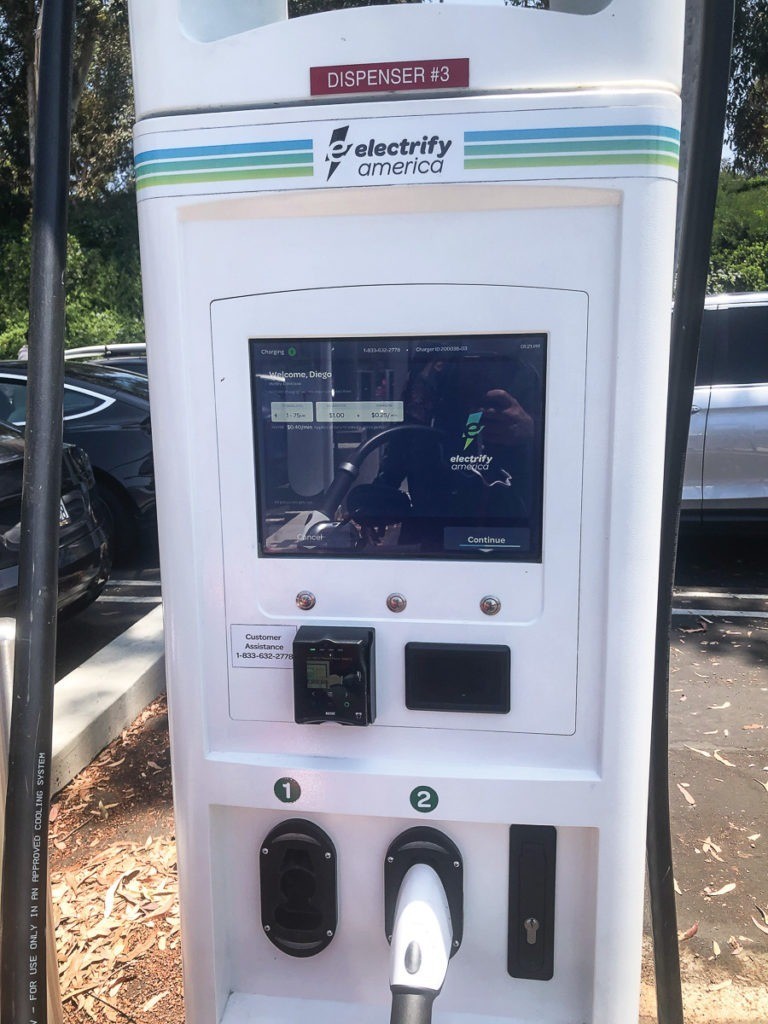
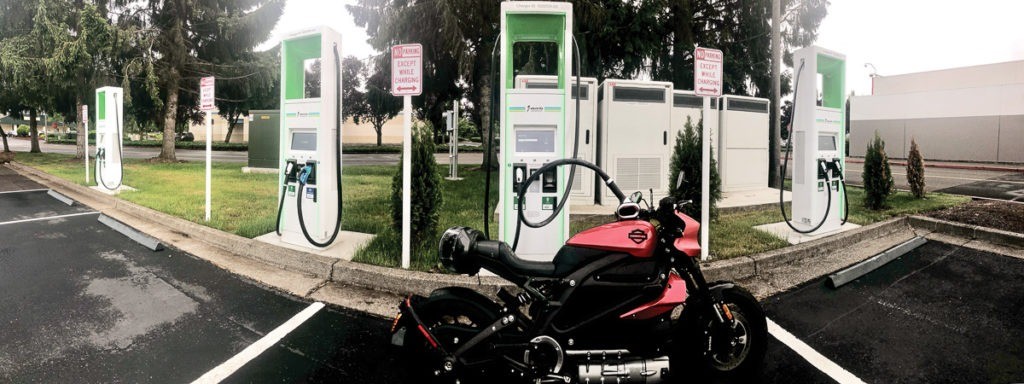
On the 28th of June, they were just 100 miles from the border, and his wife suggested they wait and hit the border on his birthday, the 30th. So they took the day off. On the 30th, they headed towards the Canadian border. “At my last charge stop, my wife had me go to Walmart to get something – I had no idea why she wanted me to go to Walmart – and when I got back she’d decorated the whole charging station for my birthday.”
“I hit Peace Arch Park on the 30th,” he continued, “which is shared by the U.S. and Canadian government. I talked to border patrol agents and they said I couldn’t get across unless I said I was going to Alaska, but if you mess around in Canada, they’ll deport you right now. Well, I didn’t want that, so I hung around the park, had some cake, and said I did it! I officially broke the record doing the border-to-border trip.”

Harley-Davidson, who’s widely broadcasted the details of Cardenas’ historic road trip aboard the LiveWire, weighed in. “Diego is a wonderful example of the best kind of customer,” said Harley-Davidson PR rep Jen Hoyer. “He’s genuine in his enthusiasm for Harley-Davidson, but also an advocate for the lifestyle we encourage – to get out and ride safely at this time. His epic 50th birthday trip has encouraged many others to do responsible road trips right now, and as a passionate LiveWire owner he’s also inspiring others to try something new like the awesome electric LiveWire.”
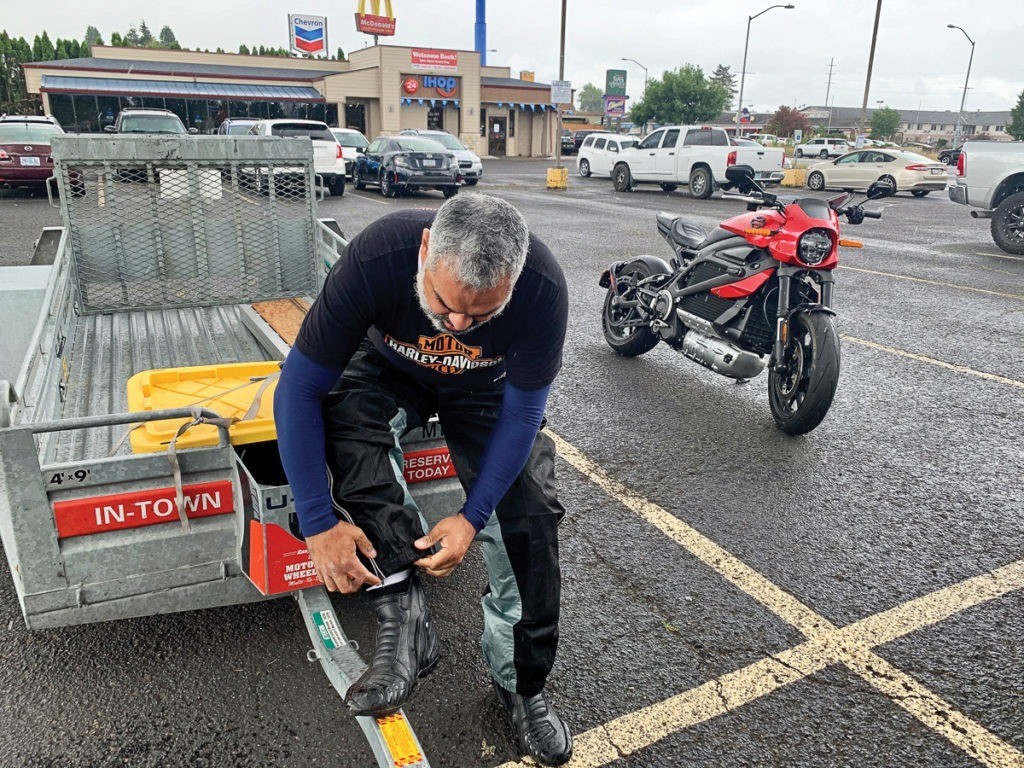
Sure, it was no Iron Butt, but Cardenas says maybe that will be his next challenge. He’s already thinking about a trip from LA to Miami via the Electrify America route.
What he wanted to do was inspire people to ride electric motorcycles and to prove what they can do, and he’s done that. “Since my trip,” he told us, “I have inspired more than one person to take the bike on long trips. They contact me for guidance and support. I just helped a 24-year-old make the trip from Florida to Sturgis – about 2200 miles – aboard the LiveWire. Once there, he entered his stock LiveWire into the Sturgis AHDRA drag races. He beat all other gasoline-powered motorcycles (Harleys and everything else) and won first place! That goes to show you that the power and the performance of an EV bike can meet, and even beat, most of the gasoline bikes on the street.”
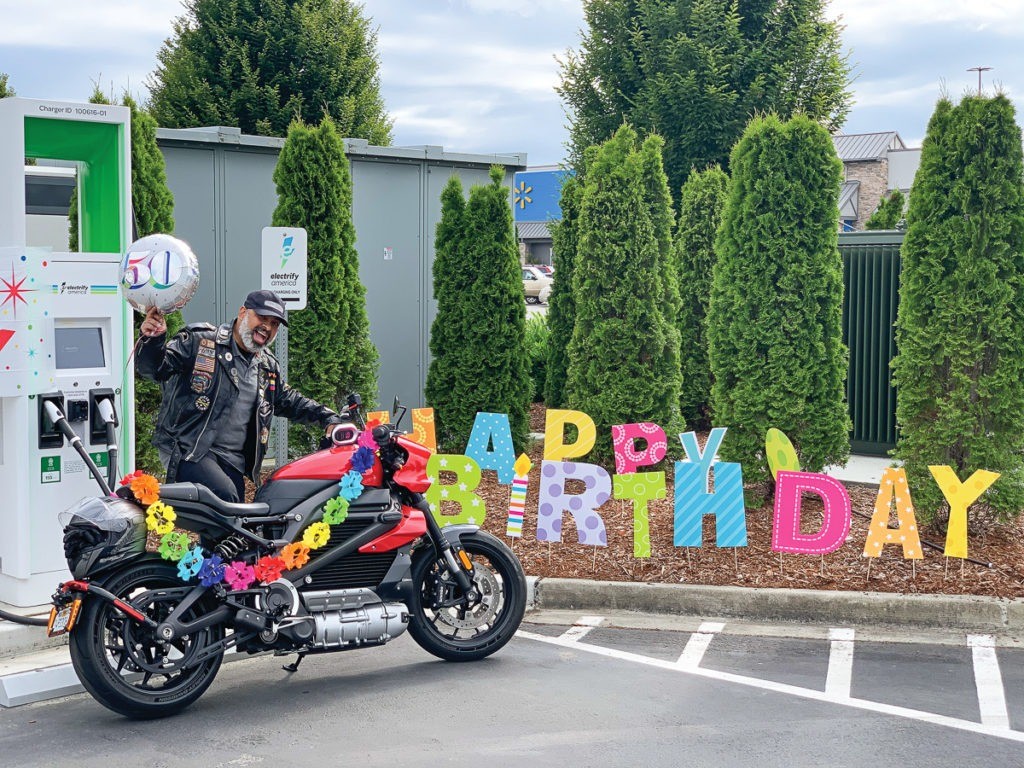
Cardenas’ love affair with the LiveWire not only inspires others, but its brought together EV riders from across the world. He created what’s now the largest LiveWire Facebook group, runs a LiveWire Facebook page and recently started a YouTube channel about the LiveWire and related topics. You can also follow his LiveWire adventures on his personal Instagram page.

“I wanted to do something different,” said Cardenas, “and different became extraordinary!”
Cardenas on EVs
EV bike owners and even Harley-Davidson dealers turn to Cardenas for his expertise on not only the LiveWire, but the EV revolution in general. We asked him some of our biggest EV questions, and he shared some of his insights. (Answers have been edited for length and clarity.)
How do we get consumers, especially motorcyclists, to support EV adoption? More and affordable bike options? Education? Test rides? Tax credits?
All of these should be explored and implemented to get consumers to look at the new phenomenon of EV adoption for motorcycles. Most importantly, manufacturers have to embrace and see EV technologies not as a cost center, but as a future profit center.
The current market share of the EV motorcycles market is very small and it is dominated by startups which have great technical expertise but lack the sales abilities that are required to mass distribute an electric bike.
There has to be a push and pull strategy to get this rolling. Look at Tesla. In the beginning they had a hard time getting their cars to into the hands of their premium clients, but as soon they showed that their cars performed equally and, in most cases, better than comparable cars in their class, is when the consumers took notice.
While this was happening they couldn’t rely on the third-party development of a charging network (10 years ago), so they ventured into developing their own EV charging network which enabled these cars to have the autonomy and range that users demanded. Their client base is also their fan base, which also act like external sales reps for the company. Tesla’s business model is a prime example of how to design, build and deploy an automotive disruptive technology.
Charging infrastructure appears to have been focused mainly along transportation corridors. How important is it to broaden charging areas to fulfill motorcycle riders?
One example is the gasoline station network. When the first cars came out we did not have gasoline stations every few blocks. What we had were hardware stores in towns who sold the drivers the gas cans for their vehicles. This limited the locations where ICE cars could be driven to or how far they could go.
As we see the adoption of more low range EV we will see more deployments of infrastructure just like we now see gas stations. Keep in mind that motorcycles are also getting better and better range. For example, the LiveWire from five to six years ago had a range of 50-70 miles the production bike has 100-146. We also have other manufacturers who now have a 200-mile range.
I personally see solar as a very viable solution to easily deploy self-sustaining stations. Companies such as Envision Solar are already developing such technologies, which will accelerate the deployment of an electric vehicle station network worldwide. These stations can be paired up with battery storage to create microgrids.
How important is it to bring in private and public dollars to support charging networks?
It’s important to use public and private funding. We see companies like Electrify America, which is basically funded in part by VW diesel scandal settlement. At the moment the biggest long-range infrastructure development is from the private sector. It is deploying nationwide networks to service all EVs.
What are the limitations to Harley-Davidson’s reliance on Electrify America’s investment plans? And should American manufacturers create a unified charging policy, allowing all brands to tap into the same chargers? For example, Tesla has Tesla-only chargers.
Think of charging vendors as gas station vendors – we need to have as many as possible to drive competition, which leads to innovation and lower prices. Tesla built their own because at the time there was no better option to accelerate the acceptance of their cars in the market. Harley and all other EV motorcycle vendors are using industry standards and are not developing a proprietary charging network, which is a benefit for the industry as a whole.
What are the pros and cons of Harley’s LiveWire development paired with plans of eBicycles, electric scooters and a XR750-inspired EV motorcycle?
I think HD is trying to build that customer relationship very early on. Get them used to the brand and the offering, and as they grow older they will gravitate to the smaller EV bikes like the XR to eventually get future electric cruisers, which are being developed as we speak.
Lastly, given the current state of Harley-Davidson’s undisclosed Rewire plans, how detrimental in the long run would it be if Harley slowed, or cancelled, EV development?
As far as I know from the earning conference call EV is still on the development track. In the last set of restructuring layoffs EV related staff was not let go. This tells me that they are bullish on the EV movement and want to continue their leadership in this field.
Resources for planning EV motorcycle trips:
https://abetterrouteplanner.com/
https://www.evtripplanner.com/planner/2-8/
https://www.zap-map.com/route-planner/
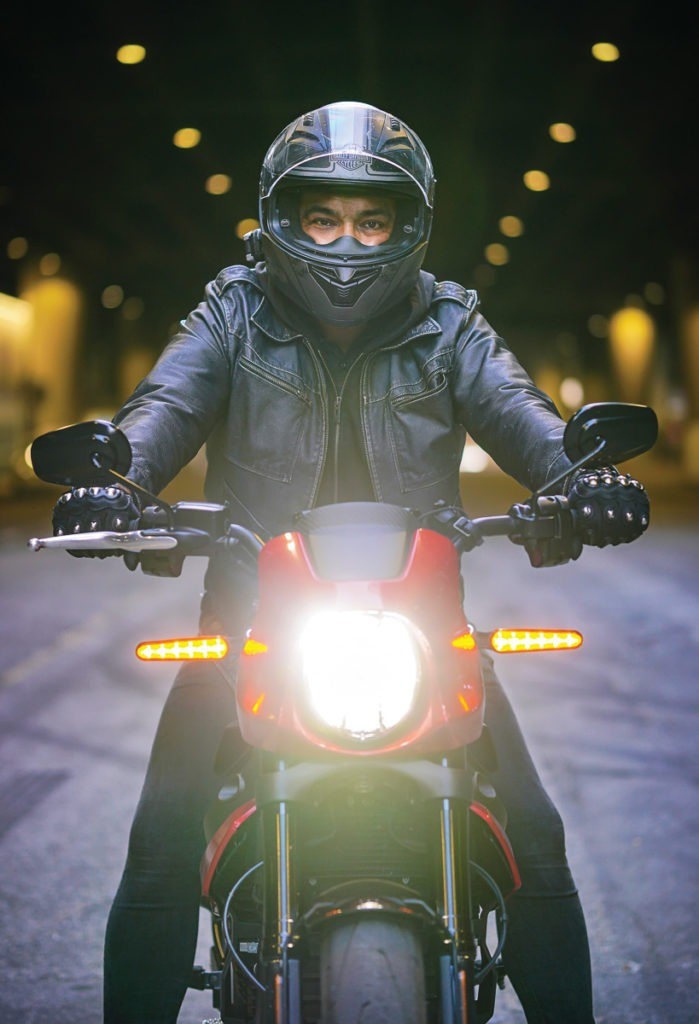
“A LiveWire rides like no other bike, and splitting lanes on that bike is awesome. It gives you a sense of boldness that you don’t get with a gas-powered bike…it accentuates the positives a bike has over a car.”







